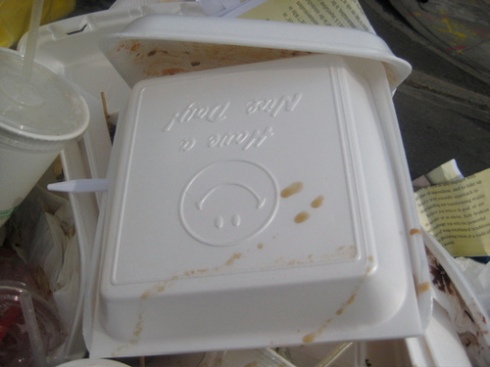She had that number right, though it may be slightly dated. The statistic came from the National Toxics Campaign (now defunct). But according to their research, in this country alone, we were tossing away 25 billion of those styrofoam cups every single year. But that's just the cups. That doesn't even count all those to-go containers that are used once and discarded, like the formerly happy meal above left.
With a bit of clicking, I was able to find out way more about styrofoam (aka polystyrene) than I ever wanted to know. Here:
Polystyrene has serious negative impacts on workers producing it. According to the Foundation for Advancements in Science and Education, styrene, a component of polystyrene, leaches into food from polystyrene foodware. Styrene has been found in 100 percent of human tissue samples and 100 percent of human nursing milk samples tested. There is evidence that styrene is a carcinogen and neurotoxin and it has also been linked to reproductive problems.
Styrene has also been linked to increased levels of chromosomal damage, abnormal pulmonary function and cancer in workers at polystyrene and styrene plants. After determining the level of exposure to styrene at which workers suffer chromosomal abnormalities, both Germany and Finland established permitted levels of exposure that are much lower than levels permitted in the United States.
Manufacturing polystyrene is also a major producer of pollution. In 1986, EPA ranked the 20 chemicals whose production generated the most hazardous wasted. Polystyrene was number five.
Polystyrene recycling programs are heavily subsidized by polystyrene manufacturers to improve the environmental image of their products.60 Furthermore, polystyrene recycling is not "closed loop" - collected polystyrene cups are not remanufactured into cups, but into other products, such as packing filler and cafeteria trays. This means that more resources will have to be used, and more pollution created, to produce more polystyrene cups.Now there are some folks claiming that it's still better than using paper cups. Their reasoning is that it costs more energy to produce the paper cups, and that customers always seem to need the extra paper sleeve (which the foam cups don't need), thus causing still more waste. They also claim that foam cups can be recycled, about which see above. Moreover, it turns out that when polystyrene waste is incinerated, dioxin is one of the byproducts. That looks like the dealbreaker right there, if you haven't got there yet.
But it's also important to remember that when you drink a beverage from a foam cup, you are also, in some measure, drinking the cup. Especially if you happen to enjoy lemon juice in your iced tea. Of course, the paper vs. foam debate is easily resolved with the use of ceramic travel mugs, which also have the benefit of better-tasting coffee.
PS: If you don't feel guilty enough yet, try "Shocking Facts About Waste." Then go recycle something.

No comments:
Post a Comment